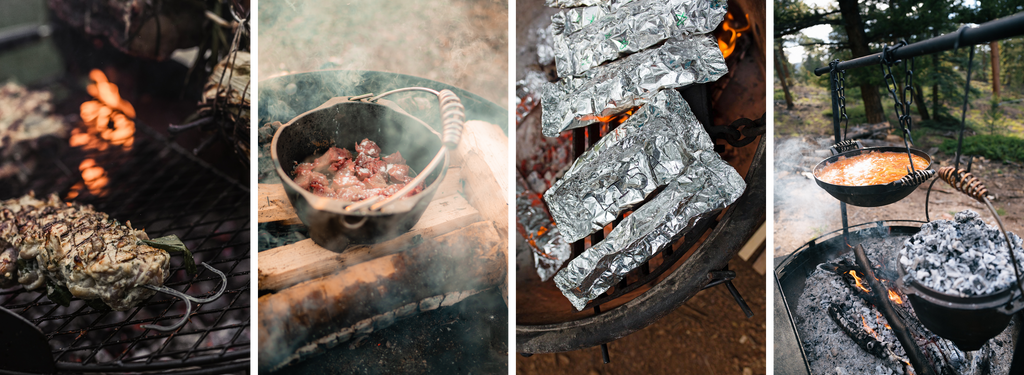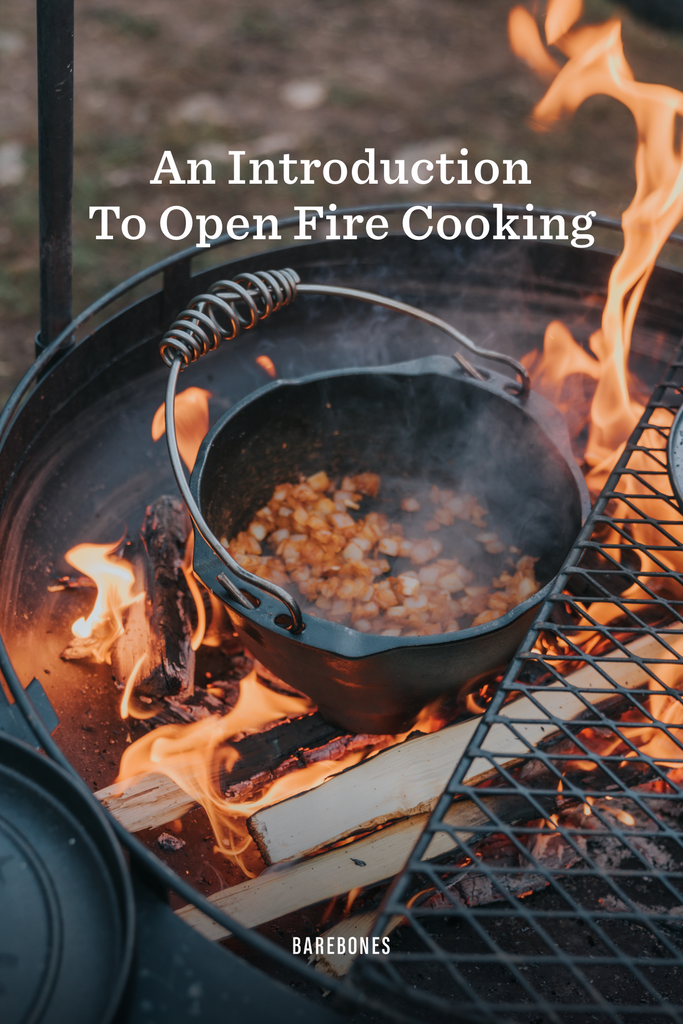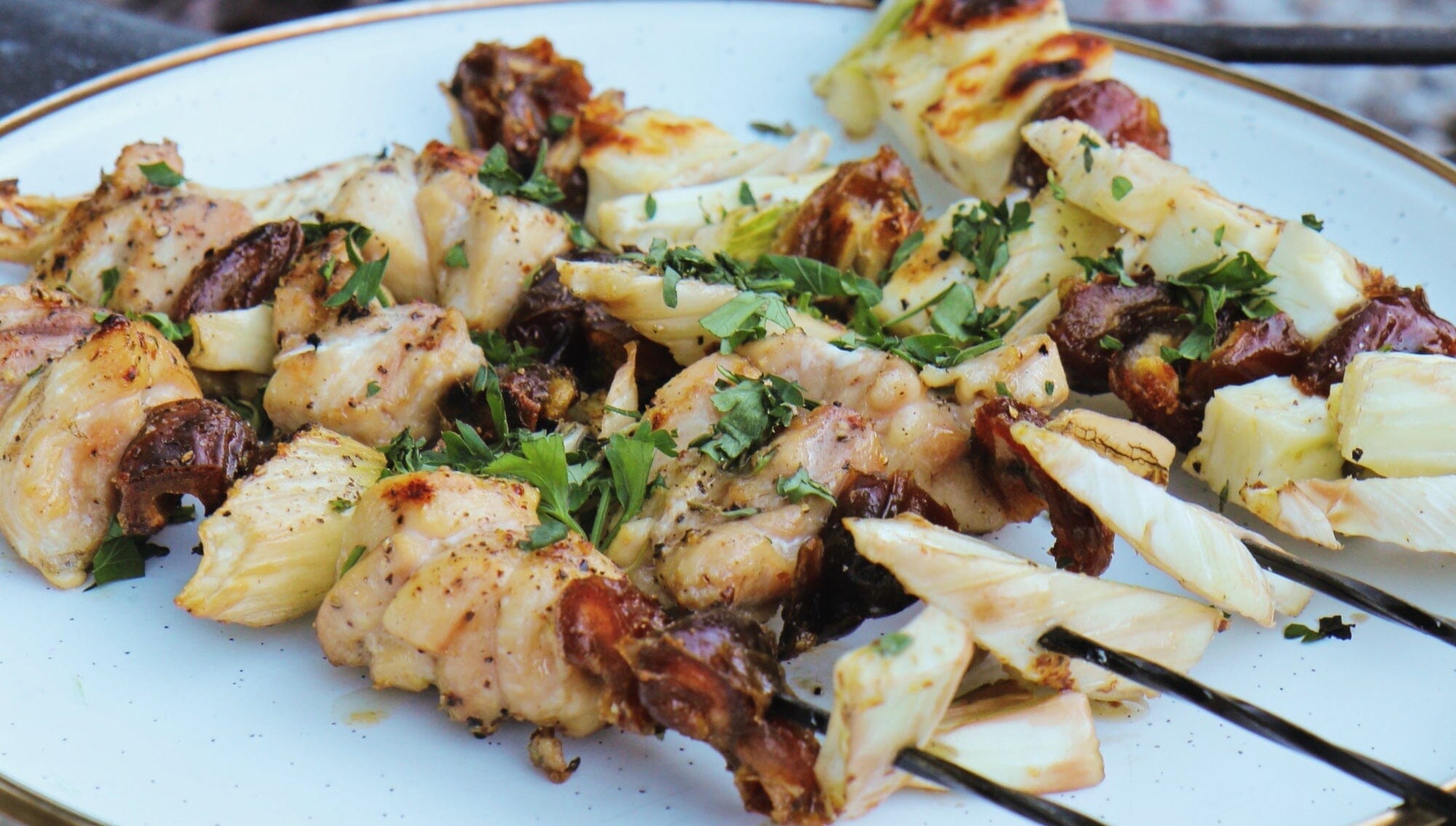· · ·
What Is Open Fire Cooking?
If you’ve ever grilled a steak or roasted a marshmallow over a bonfire, you’ve experienced open fire cooking. Open fire cooking is pretty self-explanatory: it includes a variety of cooking methods that are used outdoors over an open fire, typically made using firewood or charcoal.
Open-fire cooking has a history that dates back to the cowboy culture of the Wild West: specifically, the chuck wagon system used by cowboys driving cattle across the country. The chuck wagon operated as a diner on wheels. The camp cook provided the valuable role of cooking hearty meals for the crew and maintaining the morning and evening fires.
The re-emergence of open-fire cooking has drawn participants from all walks of life. From Van-lifers to professional chefs, people from all walks of life are enjoying the primal satisfaction of cooking with natural elements and creating the perfect atmosphere for a meal outdoors. In fact, the desire to master open-fire cooking has created a demand for classes, workshops and competitions designed to educate and enhance the outdoor cooking experience.
For many, however, the draw of open-fire cooking isn’t so much about the competitions and challenges but honing a craft that’s totally unplugged from the high-tech world that takes up so much of our lives. Open-fire cooking is a practical skill in all terrain and still delicate enough a process to be considered an art. Unlike its close cousin (barbeque), open-fire cooking does without Bluetooth thermometers, phone timers, or recipes found online. Instead, it’s about slowing down, reconnecting with nature, and doing the hard work of crafting a meal by hand – with no shortcuts.
As you might’ve guessed, the key to successful open-fire cooking is a hearty fire. If you’re at home or in an established campground, it’s easy enough to light a grill and get cooking. But if you’re starting a fire from scratch, we’ve assembled multiple methods to build a campfire using wood or charcoal.

· · ·
Ways To Cook On Open Fire
| With a stick: One of the simplest ways to cook over an open fire is roasting with a roasting stick: best used when the end of the stick is whittled to a point, avoiding depositing debris or large holes inside food. Perfect for s'mores, hot dogs, or kebabs, this method allows each person to cook to their preference - and requires minimal equipment and cleanup. Ready to try? Read our blog on five non-traditional foods to roast on a stick.
| With a cast iron skillet or Dutch oven: If you ask us, a sturdy cast iron skillet and a spacious Dutch oven are the two must-haves for all cooks, whether you’re at home or cooking outdoors. These tools provide an easy introduction to outdoor cooking for beginners, as you’re able to control the heat much easier than cooking directly in the fire. Plus, many of the best camping recipes for a cozy campfire meal are prepared in a Dutch oven: think chili, stews, and flavorful braises, perfect for a chilly night spent outdoors.
| In foil packets: Breakfast, lunch, dinner, and everything in between can be cooked in foil packets. Foil cooking helps dishes like potatoes and salmon retain moisture - and makes it possible to cook dishes that include liquids like butter, eggs, or sauce without a mess. Simply wrap your meal tightly in foil, being sure to tightly fold or crimp the edges to avoid getting ash in your food.
| Directly on coals: Cooking your food directly on hot coals is a remarkably traditional way to cook over an open fire. Hot coals are burnt sterile, and are safer to eat off of than your average picnic table. Cooking meat using this method is a breeze: the hot coals sear the meat and create a delicious, crispy crust that prevents the coals from sticking to your food. Foods that blister, like peppers and chiles, cook well on coals, as well as foods that develop extra flavor when smoked or charred, like onions and corn. Your food will cook quickly, so keep an eye out. Find tips on when to use coal vs natural wood here.
Basic Equipment For Open Fire Cooking
Metal Grill GrateIf you’ve barbequed or grilled, you’ve likely used a grate. More than anything, it’s a simple way to try out open-fire cooking styles. For example, you can set food directly on the grate if it benefits from a little charring (like barbequed meats or corn on the cob), or use it as a flat, heated surface on which to place skillets and pans.
It’s true, many picnic sites come equipped with built-in grill grates - but by packing your own, you can rest easy knowing exactly what food was cooked last. Plus, the easy transportability of a personal grill grate allows for much more flexibility in cooking - and it’s the ideal backup if you find your campsite bereft of its own grate.
Roasting SticksA simple and minimal addition to your outdoor adventures. In a pinch, find a clean wooden stick and embrace the rustic nature of outdoor cooking.
TongsA versatile kitchen tool that comes in handy nearly every time you cook. Save your fingers from flames and piping-hot foil, and easily handle items on a grill grate.
A versatile and sustainable tool that works both as a potholder, protecting your hands from hot cast iron, and also as a trivet for setting your hot skillets or pans on a table (especially necessary if covered with a plastic or synthetic tablecloth).
Aluminum FoilPerfect for mess-free meal prep and individual-sized food portions, or quick and simple cleanup for a messy meal. Plus, foil wraps leftover food in the perfect-sized packets to reheat directly in the fire the next day.
Your favorite Cast Iron StaplesA cast iron Dutch oven or skillet is resilient, easy to clean, and opens the door to amazing slow-cooking options that you typically only enjoy at home.
Cowboy Firepit GrillThe Cowboy Fire Pit Grill is truly the ultimate system in flexible, versatile, and creative open-fire cooking. The body is a steel firepit bowl with adjustable legs, and comes with a moveable grill grate as well as a suspension bar: perfect for hanging a Dutch oven or kettle over controlled heat. Each component of the system packs into the firepit bowl itself, transporting easily from home to the great outdoors. The Cowboy grill is a perfect example of elevated outdoor cooking: it allows you to go back to the basics of open-fire cooking, while having every component you need within arm’s reach.
The Do’s And Don'ts Of Open Fire Cooking
- DO be mindful of what you’re using. This means avoiding plastic spatulas, rubber mats, or even pots and pans with rubber-coated handles. These could burn your hands or melt away completely, leaving a toxic mess. And remember flip-flops, long shirtsleeves, or the frayed ends of your denim shorts can catch fire, too.
- DON’T build your fire in an unsuitable location. Instead, try to build the best type of campfire for your current conditions. If you’re in your backyard or an official campsite, stick with the provided grills or fire pits. But if you’re totally on your own, look for a rocky area to build your fire, or opt for plain, bare soil. Build your fire out of the wind and away from any trees, shrubs, or overhanging branches (in case of a stray spark). Always check the area’s outdoor fire requirements before arriving.
- DON’T forget: flames don’t cook food - heat does! Your fire might not be ready for cooking as soon as it blazes. Instead, allow the coals or embers to get hot, through and through, and produce enough steady residual heat to cook the food without charring or burning. In fact, the size of the flames hardly matters at all: some of the best open-fire cooking conditions occur when the fire dies down and the coals glow red-hot.
- DO plan your meals ahead of time. A little creative packing can go a long way: mix marinades or seasoning blends ahead of time, pre-shred chicken, chop your veggies and label different meal components if needed.
- DON’T cook outdoors without a trial run first, especially if you’re testing a new recipe. Get comfortable using your equipment and both starting and putting out a fire.
- DO be informed on the correct methods to put out a fire. (Hint: it goes beyond a bucket of water!)




